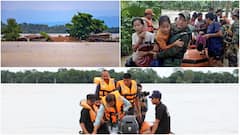Assam Battles Severe Floods: 6 Lakh Affected, Kaziranga National Park At Risk — Top Points
Assam floods: A staggering 6.4 lakh people from 1,275 villages across 19 districts were affected, forcing 8,142 persons to seek refuge in 72 relief camps across 11 districts.

Over a month after the monsoons arrived in the Northeast on June 10, Assam continued to suffer from severe flooding after days of relentless rainfall. The floodwaters submerged thousands of villages, dispatched hundreds of thousands of people, and threatened the region's fragile ecosystems, including Kaziranga National Park.
#WATCH | Water level remains high in Brahmaputra river, in Guwahati following incessant rainfall in parts of Assam and its neighbouring states pic.twitter.com/rZdNx5rAXU
— ANI (@ANI) July 2, 2024
#WATCH | Severe waterlogging in the premises of the Court of District & Sessions Judge in Assam's Dibrugarh due to continuous rainfall in the area. Emergency response personnel use inflatable boats to navigate here pic.twitter.com/bkTJlGG4M5
— ANI (@ANI) July 2, 2024
Assam Flood Crisis: Top Points
- A staggering 6.4 lakh people from 1,275 villages across 19 districts were affected, forcing 8,142 persons to seek refuge in 72 relief camps across 11 districts, an Indian Express report said.
- The situation worsened due to the overflowing of key rivers such as Bharmhaputra, Desang, Subansiri, Dekhow, Buridehing, Beki, and Barak. These rivers breached their banks, causing widespread destruction.
- Arunachal Pradesh also faced similar challenges, leading the Itanagar district administration to close schools until July 6 due to the worsening conditions.
- Assam Chief Minister Himanta Biswa Sarma emphasised that the next 3-4 days would be critical for the state, as the India Meteorological Department (IMD) forecasted moderate to heavy rain in the coming days. The state administration prepared for a potential deterioration in the situation, the Indian Express report said.
- As the floodwaters rose, authorities launched daring rescue operations. On Tuesday, the Indian Air Force (IAF) airlifted 13 fishermen who had been stranded on a riverine island in Dibrugarh district since June 28.
- The situation became so dire that a rescue team in Dhemaji district, comprising nine personnel from the State Disaster Rescue Force and the Fire and Emergency Services, had to be airlifted on June 30 after their boat capsized in the Siyang river during an ongoing operation.
- Kaziranga National Park, a UNESCO World Heritage Site known for its population of one-horned rhinoceroses, was also severely impacted by the flooding. With 95 out of 233 forest checkpoints inundated, wildlife in the park migrated to the neighbouring hills of Karbi Anglong, showcasing the resilience of these species in the face of the deluge.
- Four hog deer perished in the floodwaters. Forest department officials worked to rescue and relocate affected animals to safer areas.
- With the IMD predicting continued heavy rainfall in the coming days, the state administration raced against time to strengthen its emergency response and ensure the safety of its citizens. The Assam Rifles were deployed to rescue stranded individuals in Namsai and Changlang districts of Arunachal Pradesh. Around 500 people were rescued as of Monday evening, demonstrating ongoing efforts to mitigate the crisis.
- After the monsoon arrived in Assam on June 10, the weather department recorded an average rainfall of 41 mm in 24 hours on June 17. The IMD predicted moderate rainfall over the following five days, with heavy to very heavy rainfall likely in isolated places.
Assam experienced several rounds of floods each year. The lowlands and riverine areas bore the brunt of the deluge. This flooding pattern usually repeated annually, but at times, it was disrupted. This year, the pattern was disturbed by unusually high rainfall and the failure of critical embankments, leading to unpredictable mega-floods.
Related Video
Punjab News: AAP Leader Shot Dead During Wedding in Amritsar





































